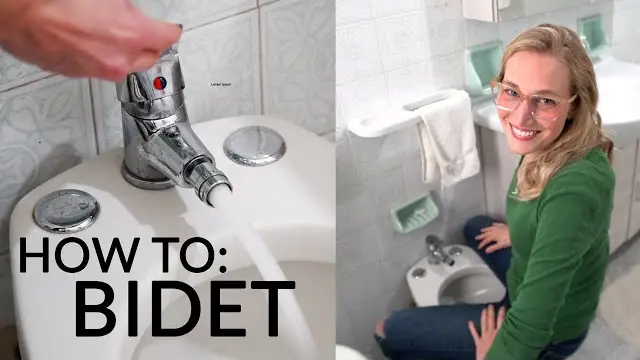
A bidet is a specialized bathroom fixture for washing your undercarriage. It’s the primary way that many people around the world clean themselves up after using the toilet. Modern bidets spray a targeted stream of water exactly where you need it, cleaning up even your worst messes gently and easily.
Do you still wipe with a bidet?
 If you are using the bidet properly, and if your bidet is of high quality, you should not have to use toilet paper to wipe yourself clean. A high-quality bidet will clean your backside more thoroughly than any amount of wiping. However, you may want to use a small amount of toilet paper to dry yourself.
If you are using the bidet properly, and if your bidet is of high quality, you should not have to use toilet paper to wipe yourself clean. A high-quality bidet will clean your backside more thoroughly than any amount of wiping. However, you may want to use a small amount of toilet paper to dry yourself.
How does a toilet bidet seat work?
How to use a bidet – Bidets are typically made up of a device that you install into your toilet seat. It sprays water onto your underside, to help rinse off any fecal matter or otherwise. In short, here’s how to use the bidet:
- When you’re ready, you turn on the bidet via a button or knob
- Positioned within your toilet properly, it will deliver a jet of water onto your rear (advanced models can adjust water temperature and pressure and even dry you afterwards)
- Afterward, you can dry yourself using toilet paper — you’ll typically require much less than normal to get the job done.
Why do people use bidet toilet?
A modern bidet that resembles a traditional type A bidet ( or ) is a bowl or receptacle designed to be sat on in order to wash one’s genitalia, perineum, inner buttocks, and anus, The modern variety has a plumbed-in water supply and a drainage opening, and is thus a plumbing fixture subject to local hygiene regulations.
The bidet is designed to promote personal hygiene and is used after defecation, and before and after sexual intercourse. It can also be used to wash feet, with or without filling it up with water. In several European countries, a bidet is now required by law to be present in every bathroom containing a toilet bowl.
It was originally located in the bedroom, near the chamber-pot and the marital bed, but in modern times is located near the toilet bowl in the bathroom. Fixtures that combine a toilet seat with a washing facility include the electronic bidet, Opinions as to the necessity of the bidet vary widely over different nationalities and cultures.
In those cultures which use it habitually, such as in parts of Western, Central and Southern Europe, Eastern Asia and some South American countries such as Argentina, it is considered an indispensable tool in maintaining good personal hygiene. It is rarely used in sub-Saharan Africa and North America.
“Bidet” is a French loanword meaning ” pony ” due to the straddling position adopted in its usage.
Is a bidet more sanitary than wiping?
Yes, bidets are sanitary. In fact, using a bidet is more sanitary than using a traditional toilet and toilet paper. Bidets use water to cleanse and wash away any leftover urine or fecal matter – no wiping required. While some users dry themselves with toilet paper after rinsing with a bidet, the fecal matter has already been washed away.
Therefore, users are less likely to get bacteria on their hands, even if they do wipe a little. Some more luxurious bidet models feature self-rising toilet seats and automatic flushing. These features eliminate hand-to-toilet contact. Many models, including the Prodigy Smart Toilet, have different stream settings for feminine hygiene.
Furthermore, bidets equipped with a warm air-dryer eliminate the need to wipe dry. Using a toilet and toilet paper require the user to wipe away fecal matter, which exposes the user to getting bacteria on their hands and leaving remnants of bacteria behind.
- The quality of the toilet paper is another variable, as lesser quality toilet paper is prone to flaking and tearing.
- There may also be flaws in the crumpling or folding techniques used to protect the user’s hand during the wiping process.
- When using a bidet, it is important to rinse the anal area thoroughly after you have done your duty.
Bacteria, if left alone, can grow and spread to other parts of the body, potentially leading to bacterial infections. Toilet paper can help spread bacteria to other areas of the body as opposed to washing it away entirely with a bidet.
Why bidet is not popular in America?
Bidets have been around for over 300 years – the first known bidet appeared in France in the 1700s. People all over the world use it as a standard in their bathrooms, but Americans haven’t caught on yet. Americans use about 34 million rolls of toilet paper a day. Investing in a bidet can significantly lower your spending on toilet paper.Using a bidet is cleaner than just using toilet paper and can lead to fewer instances of rashes, hemorrhoids, and UTIs. Some basic bidet toilet seat attachments can cost as low as $25 on Amazon. Visit Business Insider’s homepage for more stories.
Following is a transcript of the video. Michelle Yan: If you were walking barefoot in a park or yard and stepped in dog poop, would you only use a couple of napkins to wipe it off? No. You’d probably wash it off with water. And it’s for similar reasons that people worldwide use bidets to clean themselves after using the bathroom.
- In western Europe, South America, the Middle East, and Asia.
- They’re cleaner and more environmentally friendly than just plain old toilet paper.
- But there’s one place where bidets are not so welcome, which made us wonder: Why haven’t they caught on in the US? The word bidet actually means “pony” or “small horse” in French, since using a bidet is similar to straddling a pony.
And it’s in France that the first known bidet appeared, in the 1700s. But using water for cleansing had been around long before that. The Middle East, South Asia, and other regions had been using small vessels of water – called lotas or tabo – for cleansing for centuries before bidets appeared. 
 People would scoop the water with their hands to wash themselves off. At first, it was mostly for the upper class, but by the 19th century, indoor plumbing led to the bidets we have today. You might describe it as a really low sink next to the toilet. Its popularity spread from France to all across Europe and other parts of the world, except for America.
People would scoop the water with their hands to wash themselves off. At first, it was mostly for the upper class, but by the 19th century, indoor plumbing led to the bidets we have today. You might describe it as a really low sink next to the toilet. Its popularity spread from France to all across Europe and other parts of the world, except for America.
- Part of the reason is that bidets got a bad reputation.
- Americans first saw them in World War II in European brothels, so, many associated them with sex work.
- By the time Arnold Cohen tried to introduce them to America in the 1960s, it was too late.
- He couldn’t seem to defeat the stigma, and he quickly discovered that no one really wanted “to hear about Tushy Washing 101.” In the meantime, Japan was taking bidets to the next level.
Toto, a Japanese company, made some of its bidets electric. So, why hasn’t America embraced the bidet? Well, bathrooms in the US aren’t really built for bidets.
How does a bidet know where to spray?
How to use a handheld bidet sprayer – Bidet sprayers connect to your toilet’s water source and work essentially the same as a sprayer you might have on your kitchen sink or in your garden. After you’re done doing your business, you grab the sprayer while still sitting on the toilet, point it at the area you want to clean, and squeeze the handle.
How do you dry yourself after using a bidet?
How Do You Dry After Using a Bidet? – Sadly, there are many misconceptions regarding bidets. A common one is that the use of bidet will result in a mess and will leave you wet. That is not completely true as you can easily dry up after using it. The modern bidet seats even have drying options.
- If you press the ‘Dry’ button, provided there is one, the air dryer will dry the area.
- If you are using the traditional bidet, you can dry using toilet paper or a towel.
- In most public toilets with bidets, towels are provided on a ring next to it.
- However, using a paper towel is a more hygienic and safe option.
On the other hand, with bidet showers, chances are only part of your nether regions is wet so it becomes even easier to dry. Once you are all dried up, you can rinse the bidet or toilet to keep it clean and fresh for next use. You can now finally wash your hands with soap and dry them up using a towel or the dryer machine.
Is a bidet good for your colon?
Ulcerative Colitis – Ulcerative colitis is an autoimmune disease caused by your immune system and abnormal responses to your own body tissues. Ulcerative colitis is a chronic condition which can cause pain and discomfort, inflammation in your colon, and small ulcers that can produce mucous or pus.
You may need to go to the bathroom more frequently because your colon will want to empty often. Ulcerative colitis is one of the most common types of Inflammatory Bowel Disease, and Crohn’s Disease is the other. When you have food or bacteria in your colon your immune system mistakes these as foreign invaders and responds accordingly when you have ulcerative colitis.
The white blood cells in your body travel to your colon and line the walls, leading to inflammation and small sores called ulcers. Persistent diarrhea can be a big problem, your stool may be bloody, you may feel the need to have a bowel movement more frequently and the need to go to the bathroom may become much more urgent.
You may also experience a weight loss and lack of normal appetite. These symptoms may appear and disappear without any set schedule, and you may go for long periods in between flare ups. Approximately 700,000 Americans suffer from ulcerative colitis. A bidet can be very useful at treating some of the symptoms of ulcerative colitis, and it can make going to the bathroom easier and more comfortable for you.
Frequent diarrhea can cause irritation to the rectum as well as making it difficult to stay clean in your anal region. Water is far less irritating than toilet paper, and a soft towel can be used to pat dry so that you do not irritate or damage your rectum and anus further.
Are bidets good for females?
Benefits of a Bidet – Bidets offer women numerous hygiene benefits. During a menstrual cycle, women can use a bidet to quickly and thoroughly cleanse their genitals. Using the spray to wash outer genitals can help prevent infections, irritation, and inflammation.
- For women who are experiencing inflammation, keeping the area clean with frequent, cold water washing can help reduce it and minimize discomfort.
- Depending on the model, some bidets come with a “feminine wash” setting which thoroughly cleans a woman’s vaginal area using a wider, alternate spray pattern which creates a softer wash.
The nozzle adjusts to the appropriate position to reach the area needing to be cleaned. Another benefit of the bidet is lessening inflammation and irritation for women after childbirth. Often after giving birth, a woman’s vaginal area is sore and irritated.
- How Bidets Lessen Inflammation
- Cleanliness and Bidets
How long does it take a bidet to clean?
How long should I use the bidet spray? – It will vary depending on personal preference, but the average person will use a bidet for about 15 to 25 seconds to get thoroughly clean.
Can a bidet give you a yeast infection?
Cite – L Catarsi, G Troiano, A Bagnoli, G Messina, N Nante, Unpleasant side effects due to bidet toilet use, European Journal of Public Health, Volume 28, Issue suppl_4, November 2018, cky214.049, https://doi.org/10.1093/eurpub/cky214.049 Close
Email Twitter Facebook More
Navbar Search Filter Mobile Microsite Search Term Search Background: Very few studies have investigated the effects of bidet toilet and its habitual use. The purpose of this systematic review was to describe the side and unpleasant effects due to the use of bidet toilet.
- Methods: In January-February 2018, we performed a systematic search in PubMed using the key term “Bidet toilet”.
- Selection criteria for gathering the studies were: side effects of bidet’s habitual use; case control and cohort studies design; English language.
- Results: The research on PubMed yielded 14 publications: after title, abstract and full text’s analysis, 5 manuscripts were resulted coherent with the selection criteria.
The studies were conducted from 2007 to 2014 in India, Japan and Korea. Up to 43% of female bidet-users had altered vaginal microflora, with an increased risk of bacterial vaginitis. It was found that users with genital or anal discomfort prefer to use a bidet and there is a correlation with subjects having urological infections, vulvar pruritus and also hemorrhoids.
- It has been found that a warm water jet of low or medium pressure resulted to have the property of reducing anal resting pressure up to 14 mmHg; on the contrary a case control study suggested the relationship on anterior anal fissure.
- Conclusions: Scientific literature about this topic is really poor, and it is mostly about the bidet-toilet, which is very different from the classical bidet where there is no presence of water jet at high pressure.
Side effects of bidet-toilet remain uncertain and further studies, which include adjustment for several risk factors (such as personal hygiene, knowledge of cleaning procedures, level of instruction) should be conducted to obtain more reliable results.
Nowadays there is an increased awareness about the importance of personal hygiene, nevertheless the side effects are little known. There is a lack of literature regarding this topic, thus it is necessary to study more risk factors related to bidet-toilet use.
© The Author(s) 2018. Published by Oxford University Press on behalf of the European Public Health Association. All rights reserved. © The Author(s) 2018. Published by Oxford University Press on behalf of the European Public Health Association. All rights reserved.
I agree to the terms and conditions. You must accept the terms and conditions. Submit a comment Name Affiliations Comment title Comment You have entered an invalid code Thank you for submitting a comment on this article. Your comment will be reviewed and published at the journal’s discretion. Please check for further notifications by email.
More from Oxford Academic
How does a bidet not make a mess?
Someone had to answer it, so today’s article answers the question: do bidets tend to splash poop everywhere? One reservation folks have when considering ditching the toilet paper for a bidet is whether or not the water jet will get poop all over the place.
It’s a good question. Those who haven’t used a bidet have no idea what kind of water pressure to expect or how big the stream of water is. Do bidets spray poop everywhere? Bidets do not spray poop everywhere when used correctly, though some amount of splattering can occur. Excess pressure can cause stool to migrate to the scrotum or urethra.
Most modern bidets use a gentle stream which reduces the potential for splashing. So, with the right pressure, cleansing shouldn’t cause a mess. I should note that electric bidets use gentler streams of water of around 0.1gal/min. Non-electric bidets allow for soft streams but they use the home’s water pressure so the upper limit is much higher,
How does a bidet work for a man?
How Do Men Use A Bidet? For men, using a bidet is simple. Simply sit down and do your thing, activate the posterior wash, pat dry, and get on with your manly duties. If you’re suffering from jock itch, you could also wash the area more thoroughly and use the front wash before drying completely and applying medication.

